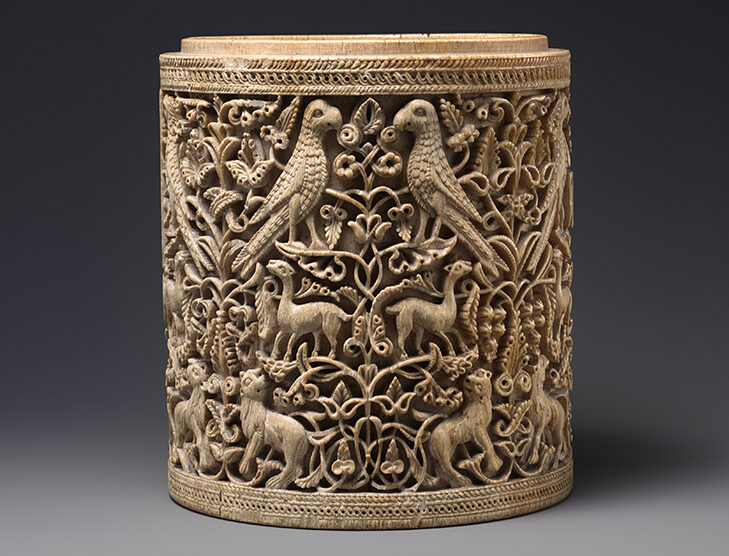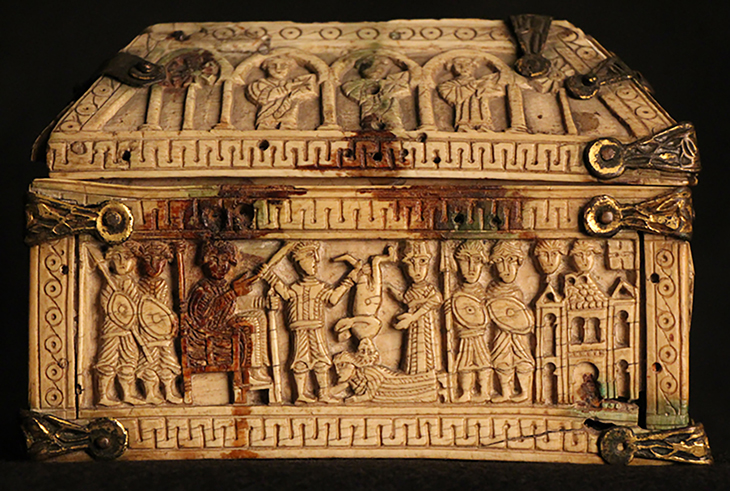From the October 2021 issue of Apollo. Preview and subscribe here.
‘Spain, 1000–1200: Art at the Frontiers of Faith’ mobilises the Met’s extraordinary resources, both artistic and architectural, to reveal the cultural forms shared across the three monotheisms of the medieval Iberian Peninsula. Those forms complement one another and show the intertwined roots of those religious cultures. Yet the exhibition is no easy assertion of convivencia; indeed, the word is completely absent here. Between the years 1000 and 1200 – though some of the objects on display are earlier or later than the period specified in the exhibition’s title – European Christianity became increasingly dominant. By the mid 13th century, the Romanesque style of Western Europe had suppressed the earlier precarious balance of common visual languages across faith groups.
Pyxis (c. 950–75), Córdoba. Metropolitan Museum of Art, New York

The Cloisters is an ideal space for revealing these medieval Iberian dynamics. Overlooking the Hudson River in Fort Tryon Park, it is suspended in greenery above New York’s swarming plain. Opened in 1938, it now comprises some seven full medieval structures – chapels, cloisters and halls. The lack of cohesion between the parts is charming, allowing visitors to meander and disappear.
‘Spain, 1000–1200’ is in the late 12th-century Chapel of San Martín de Fuentidueña. The building was ‘rescued’ – which means dismantled, moved across the Atlantic from Segovia, and attached to the rest of the museum – in the mid 20th century, opening to the public in 1961. It is a stark, clean museum space, often used for concerts and performances. The fresco, transferred to canvas, in the half-dome of the apse, is from a church in Lleida in Catalonia. It depicts the Virgin and Child in Majesty and the Adoration of the Magi. In front of it a crucifix hangs from the barrel vault, presiding over the open room. Architectural sculpture from the outside walls of the original chapel has been taken inside, alongside other pieces of Romanesque sculpture.
The apse from San Martín at Fuentidueña, Segovia, c. 1175–1200

For the present exhibition, the chapel also temporarily contains several dozen objects, small-scale and portable, that show just how deep the Met’s collection is: only two of the exhibits are borrowed from another New York institution (the Jewish Theological Seminary Library). The show makes a rich, distilled argument for the extraordinary qualities of objects travelling across and among the faiths of medieval Iberia – and for the increasing exclusivity of Christianity and Europe by this period’s end.
Art and architecture, the show argues, were the basic means by which religion was asserted and explored among Christians, Jews and Muslims in Romanesque Iberia. Remarkably for a medieval exhibition in North America, architecture makes its own case for the ways architectural and artistic styles mark the southern advance of the Christianising frontier. The Chapel of San Martín has a northern-inspired vocabulary, heavy masonry and round arches, along with its Romanesque frescoes and stone carvings. Buildings and their decorations were part of Christianity’s military occupation of the peninsula. The chapel belonged to a hilltop fortress in Castile, and its architectural forms and decoration declare its Christian European affiliation.
While the show makes convincing arguments about interfaith understanding and shared cultural forms, the balance of communal diversity was clearly tenuous. And the objects were not immune from violence. The head of a statue of Saint Martín in the chapel was severed from its body and they were reunited only when the building was remade. The head was found in the home of a local person, though its journey goes unexplored here. A headless figure also appears in the so-called Lion Relief, a painted sandstone sculpture from the Church of San Leonardo in Zamora, installed on the left-hand wall of the chapel. Iconoclasm is a sub-theme still perceptible in the objects, though it remains unexplained.
If the framing space can be interpreted as a militarised imposition of European Christian style and ideology, the objects assembled by the curators make a superb case that the three monotheisms of the peninsula shared an architectural and visual language. Among the first things visitors see are a triad of objects featuring an architectural form inextricably connected with the region: the horseshoe archway. It’s a visual motif common to the sacred art of Jews, Christians and Muslims. A Commentary on the Apocalypse from c. 945 is open at a page depicting the Heavenly Jerusalem. The 12 gates in the city’s high walls are horseshoe arches, recalling the facade of the Great Mosque of Córdoba. To the manuscript’s right is a 12th-century Andalusian gravestone with script outlined by a horseshoe arch; to the left, a 14th-century Hebrew Bible from Castile, its sacred script, too, outlined within the form. Succinctly and directly, we here see the horseshoe arch not as a frontier, as the exhibition title would have it, but as a zone of contact and mutual understanding. Such complex objects on the floor push back at the adversarial assertions of the historical framing of the chapel-museum and its original militarised context.
Ivory casket with scenes from the Book of Kings (8th–10th century), Spain. Metropolitan Museum of Art, New York

It is also worth drawing attention to the secular art on display, since these objects reveal overlapping zones that were not demarcated by religion. An ivory casket (8th–10th century) decorated with scenes from the Book of Kings, for example, has the Judgment of Solomon on one panel and a palace recalling Córdoba on another side – that shared motif of the horseshoe arch again. There is no clear declaration of affiliation, since Solomon is an important figure in all three religions. And a small ivory pyxis from 10th-century Andalusia is carpeted with a paradisal scene of lions, gazelles and parrots, the birds towering improbably large over the mammals. A theme of the show is the pan-Mediterranean cosmopolitanism of the Iberian Peninsula, and this object demonstrates the reach of those cultures, with its emphasis on the rare, exotic creatures of the east. They speak unmistakably here of wealth and worldliness, and the owner(s) of the pyxis needed no defining signs of their one God on it.
‘Spain, 1000–1200: Art at the Frontiers of Faith’ is at the Met Cloisters, New York, until 30 January 2022.
From the October 2021 issue of Apollo. Preview and subscribe here.



